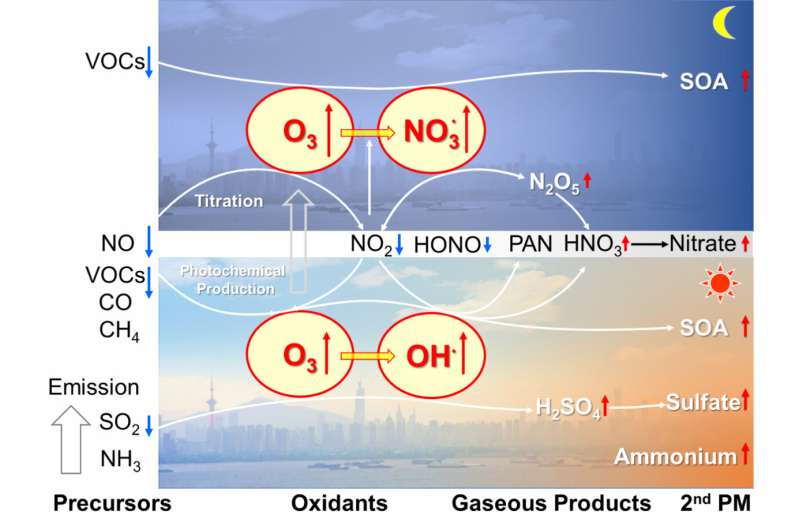Credit: CC0 Public Domain
As one of the first epicenters of this disease, China announced the most efficient prevention measures to slow down the spread of COVID-19 by restricting the movement of populations nationwide after the Chinese New Year 2020, which caused tremendous economic losses and also a substantial reduction in emissions of air pollutants from vehicles and factories. Surprisingly, despite such large decreases in primary pollution, air quality in China was not as clean as expected. Heavy multi-day haze pollution still covered northern and eastern China several times, raising questions about the well-established relationship between human activities and air quality, and even China's efforts on air pollution control that have been extensively implemented in the past few years.
Focusing on this air pollution issue, an area of concern for both the public and policymakers, the study—published in the journal National Science Review (18th June)—reveals that a sharp emission reduction in transportation caused more secondary formation of particles by enhanced atmospheric oxidizing capacity in eastern China, which offset the effort of primary emission reduction.
This study integrated multiple observational datasets, including ambient air quality monitoring networks, chemical composition measurements, and satellite retrievals, together with up-to-date emission estimations and dozens of numerical simulation experiments, to comprehensively analyze the non-linear response of air pollution to emissions reductions during the COVID-19 lockdown.
Dynamic economic and industrial statistics in the first two months of 2020 were collected to estimate emissions reductions due to COVID-19 lockdown. Thermal power generation from January to February was 8.9% lower than that in 2019, while cement production in the first two months was 29.5% lower than in 2019. Comparatively, on-road transportation had fallen off a cliff during the lockdown, with a decline in the national traffic volume of 70%.
Conceptual model showing how the secondary formation offsets the reduction of primary pollutions in China with different processes during the day and night. The upper and lower panels, indicated by moon and sun, represent nighttime and daytime processes, respectively. Blue downward arrows mean the reduction of emission or decrease of concentrations in the atmosphere, while the red upward arrows mean enhancement of production in the atmosphere. The length of these arrows indicated the degree of change. SOA, secondary organic aerosol; PAN, peroxyacetyl nitrate; HONO, nitrous acid. Credit: ©Science China Press
Such a large drop of anthropogenic emissions led to substantially decreased primary pollution in the atmosphere, particularly nitric oxide (NOx) emitted from vehicles. The nonlinear response of ozone, one important atmospheric oxidant, to NOx increased the atmospheric oxidizing capacity and subsequently accelerated the chemical production of secondary particles. Under unfavorable meteorological conditions, faster oxidation offset the emissions reduction and thus gave rise to still-severe haze pollution in the eastern China. Findings also reveal that a synchronous control of volatile organic compounds (VOCs) can serve as an effective way to overcome deteriorating haze pollution with NOx reduction.
The study shows direct and consistent 'observational' and modeling evidence on the non-linear relationship of emissions reductions and secondary haze pollution in the real world. The unique natural experiment of dramatic emissions reductions during China's COVID-19 lockdown indicate that the arbitrary reductions in NOx and other air pollutant emissions led to substantial increases in ozone, which in turn increased atmospheric oxidizing capacity and enhanced formation of secondary particles.
In China, winter haze and summer ozone pollution are the two major air quality challenges, but with different and separated control policies. Emissions regulation imposed since 2013 have successfully reduced haze pollution in eastern China, while the study suggests that the benefit of proposed further reductions in primary emissions might be offset by enhanced secondary formation of particles. A non-linear tipping-point of NOx chemistry may bring about more challenges to China's haze mitigation than anticipated. Only with coordinated and collaborative control on various primary emissions can China achieve long-term haze mitigation.
More information: Xin Huang et al, Enhanced secondary pollution offset reduction of primary emissions during COVID-19 lockdown in China, National Science Review (2020). DOI: 10.1093/nsr/nwaa137
Provided by Science China Press

























